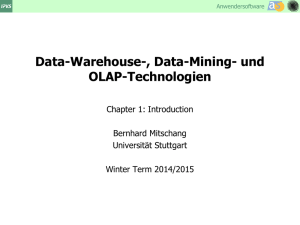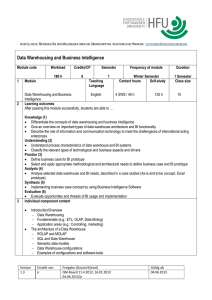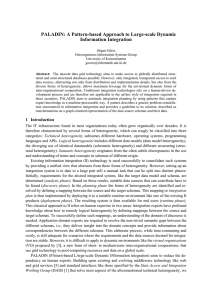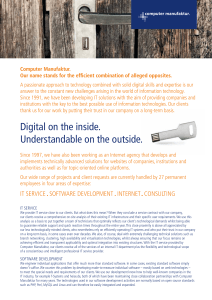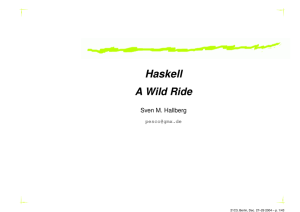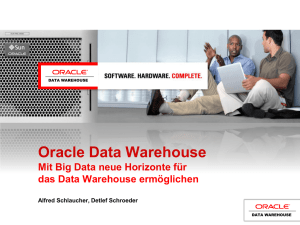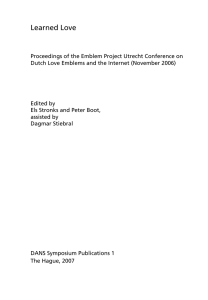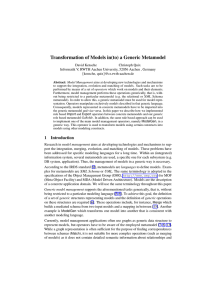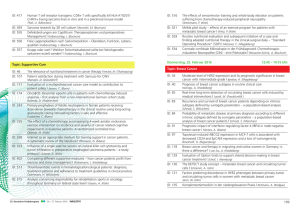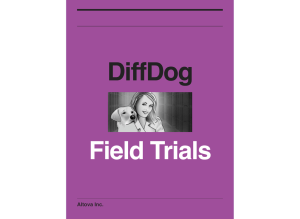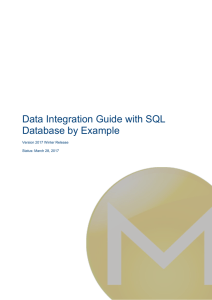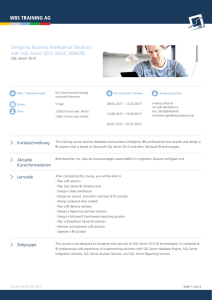Extraction, Transformation, Load
Werbung
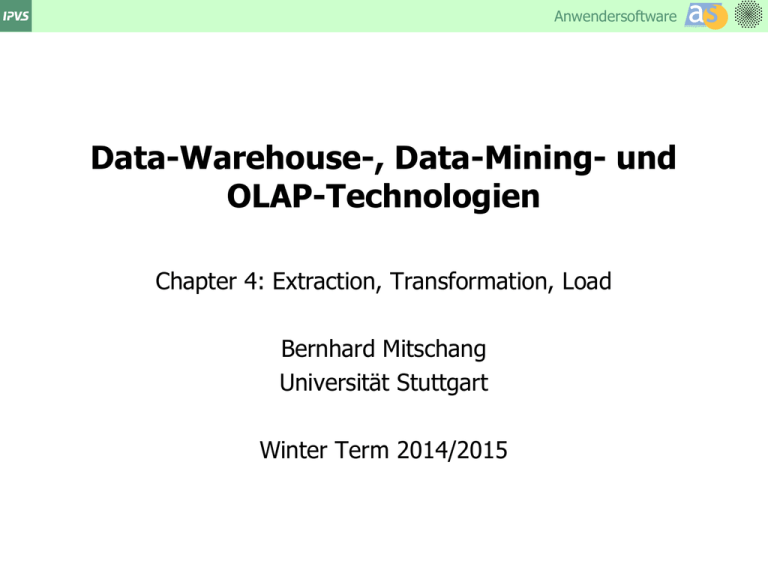
Anwendersoftware as Anwendungssoftware Data-Warehouse-, Data-Mining- und OLAP-Technologien Chapter 4: Extraction, Transformation, Load Bernhard Mitschang Universität Stuttgart Winter Term 2014/2015 Extraction, Transformation, Load Anwendersoftware as Anwendungssoftware Overview • Monitoring • Extraction Export, Import, Filter, Load Direct Integration • Load Bulk Load Replication Materialized Views • Transformation Schema Integration Data Integration Data Cleansing • Tools 2 Extraction, Transformation, Load Anwendersoftware as Anwendungssoftware Architecture data flow control flow End User Data Access Data Warehouse Data Warehouse Manager Metadata Manager Metadata Repository Load Data Staging Area Transformation Extraction Monitor Data Staging Area Data Warehouse System Data Sources (Source: [BG04]) 3 Extraction, Transformation, Load Anwendersoftware as Anwendungssoftware Monitoring • Goal: Discover changes in data source incrementally • Approaches: Based on … Changes identified by … Trigger triggers defined in source DBMS trigger writes a copy of changed data to files Replica replication support of source DBMS replication provides changed rows in a separate table Timestamp timestamp assigned to each row use timestamp to identify changes (supported by temporal DBMS) Log log of source DBMS read log Snapshot periodic snapshot of data compare snapshots source 4 Extraction, Transformation, Load Anwendersoftware as Anwendungssoftware Snapshot Differentials F1 key F2 200 A 100 A 201 U 201 X 100 A 400 Y 300 Z 202 U 100 A 201 U • • data • Fout 100 A 200 A • DELETE 200 A 201 X UPDATE 201 X 202 U INSERT 202 U 300 Z DELETE 300 Z 400 Y Two snapshot files: F1 was taken before F2 Records contain key fields and data fields Goal: Provide UPDATES/ INSERTS/ DELETES in a shapshot differential file . Sort Merge Outerjoin: • Window Algorithm: INSERT 400 Y snapshot differential Sort F1 and F2 on their keys Read F1' and F2' and compare records Snapshot files may be compresssed Snapshots are read multiple times Maintain a moving window of records in memory for each snapshot (aging buffer) Assumes that matching records are "physically" nearby Read snapshots only once 5 Extraction, Transformation, Load Anwendersoftware as Anwendungssoftware Window Algorithm INPUT: F1, F2, n OUTPUT: Fout /* the snapshot differential */ (1) Input Buffer1 ← Read n blocks from F1 (2) Input Buffer2 ← Read n blocks form F2 (3) while ((Input Buffer1 ≠ EMPTY) and (Input Buffer 2 ≠ EMPTY)) (4) Match Input Buffer1 against Input Buffer2 (5) Match Input Buffer1 against Aging Buffer2 (6) Match Input Buffer2 against Aging Buffer1 (7) Put contents of Input Buffer1 to Aging Buffer1 (8) Put contents of Input Buffer2 to Aging Buffer2 (9) Input Buffer1 ← Read n blocks from F1 (10) Input Buffer2 ← Read n blocks from F2 (11) Report records in Aging Buffer1 as deletes (12) Report records in Aging Buffer2 as inserts F1 Input Buffer 1 In case of a buffer overflow, this (oldest) record is replaced and reported as deleted buckets Aging Buffer 1 F2 age queue Input Buffer 2 TAIL HEAD Aging Buffer 2 Source: [LG96] 6 Extraction, Transformation, Load Anwendersoftware as Anwendungssoftware Overview • Monitoring • Extraction Export, Import, Filter, Load Direct Integration • Load Bulk Load Replication Materialized Views • Transformation Schema Integration Data Integration Data Cleansing • Tools 7 Extraction, Transformation, Load Anwendersoftware as Anwendungssoftware ETL Processing Data Marts Data Warehouse Data Staging Area move data to data marts files vs. tables move data from DSA to data warehouse db Load move data as part of transformations Transformation Monitor Data Staging Area Extraction Requirements: move source data to data staging area copy vs. transformation same system vs. heterogeneous systems automatic vs. user-driven availability of source and target system Data Sources 8 Extraction, Transformation, Load Anwendersoftware as Anwendungssoftware Extraction heterogeneous source systems replica active db / trigger snapshot export / db dump logging no support Integration • support of monitoring and extraction: performance • extract current data • limited time frame • service of source system should not be restricted • accessing data sources application / application API database API log files 9 Extraction, Transformation, Load Anwendersoftware as Anwendungssoftware Export and Import decompress compress Source System Export EXPORT TO OF MODIFIED BY MESSAGES SELECT FROM WHERE network c:\cust_berlin_I\cust.data DEL COLDEL | c:\cust_berlin_I\msg1.txt * customer_data new_customer = true Import Target System • Export: ASCII files proprietary format • Import: import command bulk load (DB2) 10 Extraction, Transformation, Load Anwendersoftware as Anwendungssoftware Import vs. Load IMPORT FROM OF MODIFIED BY COMMITCOUNT MESSAGES INSERT INTO c:\cust_berlin_I\cust.data DEL COLDEL | 1000 c:\cust_berlin_I\msg2.txt cust_berlin_1 (DB2) LOAD FROM OF MODIFIED BY SAVECOUNT MESSAGES REPLACE INTO STATISTICS c:\cust_berlin_I\cust.data DEL COLDEL | 1000 c:\cust_berlin_I\msg3.txt cust_berlin_1 YES IMPORT LOAD COMMIT explicit automatic Logging complete, mandatory optional Integrity check all constraints check local constraints only Trigger all none Locking read access table lock possible (DB2) 11 Extraction, Transformation, Load Anwendersoftware as Anwendungssoftware Filter and Load Input Datafiles Log File Loader Control File SQL*Loader Bad Files (Oracle) Discard Files Database Tables Indexes • Bulk load tools provide some filter and transformation functionality: Load data from multiple datafiles during the same load session. Load data into multiple tables during the same load session. Specify the character set of the data. Selectively load data, i.e. load records based on the records’ values. Manipulate the data before loading it, using SQL functions. Generate unique sequential key values in specified columns. 12 Extraction, Transformation, Load Anwendersoftware as Anwendungssoftware Direct Integration external tables database system SQL table functions database system federated database database system SQL SQL Wrapper Java, C, C++, … data source • register external data as tables • allows to read external data • no query optimization • user-defined functions provides a tables as result • function reads data from external sources data data data source sourcesource • register external data as tables • define wrapper for access to external data • exploit capabilities of external source for query optimization 13 Extraction, Transformation, Load Anwendersoftware as Anwendungssoftware Overview • Monitoring • Extraction Export, Import, Filter, Load Direct Integration • Load Bulk Load Replication Materialized Views • Transformation Schema Integration Data Integration Data Cleansing • Tools 14 Extraction, Transformation, Load Anwendersoftware as Anwendungssoftware Load Transfer data from the data staging area into the data warehouse and data marts. • Bulk load is used to move huge amounts of data. • Data has to be added to existing tables: add rows replace rows or values • Flexible insert mechanism is needed to: add and update rows based on a single data source. add rows for a single data source to multiple tables in the data warehouse. • Consider complex criteria in load processing: write application program use procedural extensions of SQL 15 Extraction, Transformation, Load Anwendersoftware as Anwendungssoftware Update and Insert IMPORT FROM OF MODIFIED BY COMMITCOUNT MESSAGES INSERT INTO c:\cust_berlin_I\cust.data DEL COLDEL | 1000 c:\cust_berlin_I\msg2.txt cust_berlin_1 (DB2) Insert Semantics? • INSERT: Adds the imported data to the table without changing the existing table data. • INSERT_UPDATE: Adds rows of imported data to the target table, or updates existing rows (of the target table) with matching primary keys. • REPLACE: Deletes all existing data from the table by truncating the data object, and inserts the imported data. The table definition and the index definitions are not changed. • REPLACE_CREATE: If the table exists, deletes all existing data from the table by truncating the data object, and inserts the imported data without changing the table definition or the index definitions. If the table does not exist, creates the table and index definitions, as well as the row contents. 16 Extraction, Transformation, Load Anwendersoftware as Anwendungssoftware MERGE INTO customer custkey Name Address 100 Ortmann Rauchstr. 101 Martin Pariser Platz 105 Fagiolo Hiroshimastr. 106 Byrt Lassenstr. cust_berlin_I MERGE INTO key Name Address 100 Ortmann Rauchstrasse 1 101 Martin Pariser Platz 102 Torry Wilhelmstr. MERGE INTO customer AS c1 USING ( SELECT key, name, address, … FROM cust_berlin_I WHERE …) AS c2 ON ( c1.custkey = c2.key ) WHEN MATCHED THEN UPDATE SET c1.address = c2.address WHEN NOT MATCHED THEN INSERT (custkey, name, address, … VALUES (key, name, address ,…) • 'transaction table' (cust_berlin I) contains updates to existing rows in the data warehouse and/or new rows that should be inserted. • MERGE Statement of SQL:2003 allows to update rows that have a matching counterpart in the master table insert rows that do not have a matching counterpart in the master table 17 Extraction, Transformation, Load Anwendersoftware as Anwendungssoftware Multiple Inserts customer custkey Name Address 105 Fagiolo Hiroshimastr. cust_berlin_I 106 Byrt Lassenstr. key Name Address 100 Ortmann Rauchstrasse 1 location Street Town Hiroshimastr. Berlin Lassenstr. 101 Martin Pariser Platz 102 Torry Wilhelmstr. Berlin INSERT ALL INTO customer VALUES (key, name, address) INTO location VALUES (address, 'Berlin') SELECT * FROM cust_berlin_I WHERE … (Oracle) • Insert rows (partly) into several target tables. • Allows to insert the same row several times. • Allows to define conditions to select the target table. • INSERT FIRST defines that the rows is inserted only once. INSERT ALL /* INSERT FIRST */ WHEN key < 100 INTO customer VALUES (key, name, address) WHEN key < 1000 INTO location VALUES (address, 'Berlin') SELECT * FROM cust_berlin_I WHERE … (Oracle) 18 Extraction, Transformation, Load Anwendersoftware as Anwendungssoftware Replication SELECT UPDATE UPDATE SELECT SELECT SELECT target system source system SELECT source system UPDATE UPDATE SELECT target system SELECT target system source system UPDATE data distribution UPDATE SELECT data consolidation SELECT update anywhere 19 Extraction, Transformation, Load Anwendersoftware as Anwendungssoftware Materialized Views End User Data Access Data Mart End User End User Data Access End User Data Access Data Access Data Mart Data Mart Data Warehouse Load dependent data marts • Data marts provide extracts of the data warehouse for a specific application. • Applications often need aggregated data. • Materialized Views (MV) allow to: define the content of each data mart as views on data warehouse tables automatically update the content of a data mart • Important Issues: MV selection MV refresh MV usage 20 Extraction, Transformation, Load Anwendersoftware as Anwendungssoftware Materialized Views Application needs number of open orders per customer Application needs number of products on order Data Mart 1 Data Mart 2 DM1_Orders DM2_Orders CNR Open Ok ANR Count 7017 1 - 100101 6 7089 - 1 100104 3 7564 - 1 210704 12 7017 3 - 100105 1 7537 1 - 210204 1 7456 1 - 120113 2 refresh DW_Orders CNR ANR SNR Count Status 7017 100101 1 5 open 7098 100104 1 3 ok 7564 210704 1 12 ok 7017 100105 2 1 open 7017 210204 2 1 open 7017 100101 2 1 open 7537 120113 2 1 open 7456 120113 2 1 open … … … … … CREATE TABLE DM2_Orders AS ( SELECT ANR, SUM(Count) FROM DW_Orders GROUP BY ANR ) DATA INITIALLY DEFERRED REFRESH DEFERRED; REFRESH TABLE DM2_Orders; (DB2) refresh • Materialized views are created like views • A strategy for refreshing has to be specified: DEFERRED: Use REFRESH TABLE statement IMMEDIATE: As part of the update in the source table 21 Extraction, Transformation, Load Anwendersoftware as Anwendungssoftware Overview • Monitoring • Extraction Export, Import, Filter, Load Direct Integration • Load Bulk Load Replication Materialized Views • Transformation Schema Integration Data Integration Data Cleansing • Tools 22 Extraction, Transformation, Load Anwendersoftware as Anwendungssoftware Transformation Convert the data into something representable to the users and valuable to the business. • Transformation of structure and content: Semantics Structure Data → → → identify proper semantics schema integration data integration and data cleansing 23 Extraction, Transformation, Load Anwendersoftware as Anwendungssoftware Transformation: Semantics • Information on the same object is covered by several data sources. • E.g., customer information is provided by several source systems. • Identify synonyms Indentify homonyms car automobile cash cache student pupil bare bear baby infant sight site • Identifying the proper semantics depends on the context. • Users have to define the proper semantics for the data warehouse. • Describe semantics in the metadata repository. 24 Extraction, Transformation, Load Anwendersoftware as Anwendungssoftware Schema Integration • Schema integration is the activity of integrating the schemata of various sources to produce a homogeneous description of the data of interest. • Steps of schema integration: • Properties of the integrated schema: completeness correctness minimality understandability preintegration schema comparison schema conforming schema merging and restructuring 25 Extraction, Transformation, Load Anwendersoftware as Anwendungssoftware Pre-Integration Analysis of the schemata to decide on the general integration policy. • Decide on: schemata to be integrated order of integration / integration process preferences 26 Extraction, Transformation, Load Anwendersoftware as Anwendungssoftware binary Schema Integration Process balanced tree one shot iterative n-ary left deep tree source schemata target schema intermediate schemata 27 Extraction, Transformation, Load Anwendersoftware as Anwendungssoftware Schema Matching • Goal: Take two schemas as input and produce a mapping between elements of the two schemas that correspond semantically to each other. • Typically performed manually, supported by a graphical user interface. tedious, time-consuming, error-prone, expensive • General architecture of generic match: tools = schema-related apps. internal schema representation + import and export needed use libraries to help find matches only determine match candidates user may accept or reject Tool 1 Tool 2 Tool 3 Tool 4 Schema Import/export Global libraries: dictionaries, schemas Generic Match implementation Internal schema representation (ER, XML, …) Source: [RB01] 28 Extraction, Transformation, Load Anwendersoftware as Anwendungssoftware Schema Comparison Analysis to determine the correlations among concepts of different schemata and to detect possible conflicts. • Schema Matching is part of this step. • Types of conflicts in relational systems: schema table / table naming • synonyms • homonyms structure • missing attributes • implied attributes integrity constraints attribute / attribute table / attribute naming • synonyms • homonyms default values integrity constraints • data types • range of values 29 Extraction, Transformation, Load Anwendersoftware as Anwendungssoftware Schema Conforming Conform and align schemata to make them compatible for integration. • Conflict resolution based on the application context cannot be fully automated human intervention supported by graphical interfaces • Sample steps: Attributes vs. Entity Sets Composite Primary Keys Redundancies Simplification 30 Extraction, Transformation, Load Anwendersoftware as Anwendungssoftware Schema Conforming A B X A B E X n E 1 A EX B X A E B EA n m EB X Attribute vs. Entity Set 1 n E1 E2 n E1 m Composite Primary Keys redundant E2 generalization E1 E23 E3 m 1 Redundancies E2 E3 E3 E4 Simplification E4 31 Extraction, Transformation, Load Anwendersoftware as Anwendungssoftware Schema Merging and Restructuring Conformed schemata are superimposed, thus obtaining a global schema. • Main steps: superimpose conformed schemata quality tests against quality dimensions (completeness, correctness, minimality, understandability, …) further transformation of the obtained schema integration transformation(s) source schemata target schema intermediate/conformed schemata 32 Extraction, Transformation, Load Anwendersoftware as Anwendungssoftware Schema Integration in Data Warehousing Integration in data warehousing schema integration and data integration schema integration is a prerequisite for data integration schema integration is mainly used for the data staging area final data warehouse schema is defined from a global point of view, i.e., it is more than only integrating all source schemata schema matching between source schema and data warehouse schema provides the basis for defining transformations Integration in federated systems focus on schema integration integrated schema is used 33 Extraction, Transformation, Load Anwendersoftware as Anwendungssoftware Data Integration • Normalization / denormalization: depending on the source schema and the data warehouse schema keys should not depend on the source system • Data type conversion: if data type of source attribute and target attribute differ • Coding: text → coding; coding → text; coding A → coding B examples • Surrogate keys: customer system local key global key 1 107 5400345 1 109 5401340 2 107 4900342 2 214 5401340 character→ date character → integer 'MM-DD-YYYY' → 'DD.MM.YYYY' gross sales → 1 net sales → 2 3 → price 2 → GS 34 Extraction, Transformation, Load Anwendersoftware as Anwendungssoftware Data Integration • Convert strings: 'Video' → ' video' 'VIDEO' → 'video' 'Miller, Max' → 'Max Miller' • Convert date to date format of the target system • Convert measures • Combine / separate attributes • Derived attributes • Aggregation examples standardization 2004, 05, 31 → 31.05.2004 04, 05, 31 → 31.05.2004 '05/31/2004' → 31.05.2004 inch→ cm km → m mph → km/h 2004, 05, 31 → 31.05.2004 'video', 1598 → 'video 1598' net sales + tax → gross sales on_stock - on_order → remaining sales_per_day → sales_per_month 35 Extraction, Transformation, Load Anwendersoftware as Anwendungssoftware Data Cleansing • Elementizing identify fields David and Clara Miller Ste. 116 13150 Hiway 9 Box 1234 Boulder Crk Colo 95006 • Standardizing format, coding • Verification first name 1: David last name 1: Miller first name 2: Clara last name 2: Miller suite: 116 number: 13150 street: Hiway 9 post box: 1234 city: Boulder Crk state: Colo zip: 95006 first name: David last name: Miller first name 2: Clara last name 2: Miller suite: 116 number: 13150 street: Highway 9 post box: 1234 city: Boulder Creek state: Colorado zip: 95006 contradictions? should lead to corrections in source system(s) • Matching first name: David last name: Miller first name 2: Clara last name 2: Miller suite: 116 number: 13150 street: Highway 9 post box: 1234 city: Boulder Creek state: California zip: 95006 is 'David Miller' and/or 'Clara Miller' already present in data warehouse? if so, are there changed fields? • Householding 'David Miller' and 'Clara Miller' constitute a household • Documenting 36 Extraction, Transformation, Load Anwendersoftware as Anwendungssoftware Dimensions of Data Cleansing single source single record • attribute dependencies (contradictions) • spelling mistakes • missing values • illegal values multiple records • primary key foreign key • duplicates / matching • householding multiple sources • • • • duplicates / matching householding contradictions standardization, coding 37 Extraction, Transformation, Load Anwendersoftware as Anwendungssoftware Data Quality consistency correctness completeness exactness reliability understandability relevance • Are there contradictions in data and/or metadata? • Do data and metadata provide an exact picture of the reality? • Are there missing attributes or values? • Are exact numeric values available? Are different objects identifiable? Homonyms? • Is there a Standard Operating Procedure (SOP) that describes the provision of source data? • Does a description for the data and coded values exist? • Does the data contribute to the purpose of the data warehouse? 38 Extraction, Transformation, Load Anwendersoftware as Anwendungssoftware Improving Data Quality • Assumption: Various projects can be undertaken to improve the quality of warehouse data. Goal: Identify the data quality enhancement projects that maximize value to the users of data. • Tasks for the data warehouse manager: Determine the organizational activities the data warehouse will support; Identify all sets of data needed to support the organizational activities; Estimate the quality of each data set on each relevant data quality dimension; Identify a set of potential projects (and their cost) that could be untertaken for enhancing or affecting data quality; Estimate for each project the likely effect of that project on the quality of the various data sets, by data quality dimension; Determine for each project, data set, and relevant data quality dimension the change in utility should a particular project be untertaken. Source: [BT99] 39 Extraction, Transformation, Load Anwendersoftware as Anwendungssoftware Improving Data Quality I: Index of organizational activities supported by a data warehouse J: Index for data sets K: Index for data quality attributes or dimensions L: Index for possible data quality projects P(1) … P(S) Value of Project L = Current quality: CQ(J, K) Required quality: RQ(I, J, K) Anticipated quality: AQ(J, K, L) Priority of organizational activities: Weight(I) Cost of data quality enhancement: Cost(L) Value added: Utility(I, J, K, L) ∑ Weight (I ) ⋅ ∑ ∑ Utility (I , J , K , L ) All I All Maximize: total value from all projects Resource Constraint: J All K 1, if Project L is selected 0, otherwise X (L ) = ∑ X (L ) *Value (L ) All L ∑ X (L ) * Cost (L ) ≤ Budget All L Exclusiveness Constraint: X (P (1)) + X (P (2)) + ... + X (P (S )) ≤ 1 Interaction Constraint: X (P (1)) + X (P (2)) + X (P (3)) ≤ 1 40 Extraction, Transformation, Load Anwendersoftware as Anwendungssoftware Overview • Monitoring • Extraction Export, Import, Filter, Load Direct Integration • Load Bulk Load Replication Materialized Views • Transformation Schema Integration Data Integration Data Cleansing • Tools 41 Extraction, Transformation, Load Anwendersoftware as Anwendungssoftware ETL Market Size 2001-2006 Source: Forrester Research, 2004 42 Extraction, Transformation, Load Anwendersoftware as Anwendungssoftware ETL Market • Vendors coming from several different backgrounds and perspectives: "Pure Play" Vendors • ETL represents a core competency • ETL accounts for most of the license revenue • This class of vendors is driving the bulk of innovation and "mind share" in the ETL market A Database Management System (DBMS) Vendors • database vendors have an increasing impact on this market as they continue to bundle ETL functionality closer to the relational DBMS Business Intelligence Vendors • Business intelligence tools and platforms are their core competency • For most of these vendors, ETL technology plays a supporting role to their flagship business intelligence offerings, or is one component of a broad offering including business intelligence and ETL B C Other Infrastructure Providers • They provide various types of technical infrastructure components beyond the DBMS • ETL is typically positioned as yet another technical toolset in their portfolios D Source: Gartner, 2004 43 Extraction, Transformation, Load Anwendersoftware as Anwendungssoftware ETL Vendors/Products Ranked By Market Share Percentages A B A A C C B A D C Source: Forrester Research, 2004 44 Extraction, Transformation, Load Anwendersoftware as Anwendungssoftware ETL Vendors/Products Ranked By Market Share Percentages B A B C D Source: Forrester Research, 2004 45 Extraction, Transformation, Load Anwendersoftware as Anwendungssoftware ETL Tools Source: META Group, 2004 46 Extraction, Transformation, Load Anwendersoftware as Anwendungssoftware Summary • Moving data is part of most steps of the ETL process: Extraction, Transformation, Loading Data Warehouse and Data Marts • Several approaches available: export, import, load direct integration replication materialized views • Transformation steps include semi-automatic schema matching and integration data integration steps data cleansing 47 Extraction, Transformation, Load Anwendersoftware as Anwendungssoftware Papers [BT99] [LG96] [RB01] D. Ballou, G. K. Tayi: Enhancing Data Quality in Data Warehouse Environments. Communications of the ACM, Vol. 42, No. 1, 1999. W. Labio, H. Garcia-Molina: Efficient Snapshot Differential Algorithms for Data Warehousing. Proc. of 22th International Conference on Very Large Data Bases, Mumbai (Bombay), India, 1996. E. Rahm, P. Bernstein: A survey of approaches to automatic schema matching. VLDB Journal 10:334-350 (2001) 48
